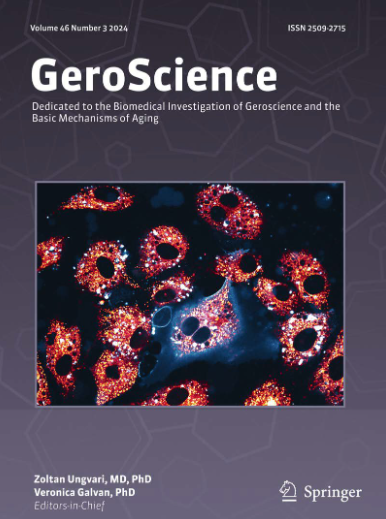Associations of accelerated epigenetic aging with cancer and mortality risk in the USA.
IF 5.4
2区 医学
Q1 GERIATRICS & GERONTOLOGY
引用次数: 0
Abstract
DNA methylation (DNAm) algorithms have been developed to assess biological aging and its association with cancer. Despite their potential, direct comparisons to identify the most accurate algorithm for predicting cancer risk and mortality remain limited. The study population (n = 2532) consisted of adults aged 50 years and older from the National Health and Nutrition Examination Survey, with 17-year follow-up mortality data. Twelve DNAm algorithms were evaluated using Illumina EPIC BeadChip array. Logistic regression models were used to assess both overall and site-specific cancer risk, while Cox proportional hazards models and Fine-Gray sub-distribution hazard model were employed to assess cancer mortality. Three hundred forty-three cancer cases were observed at baseline, and 271 cancer-caused deaths were recorded during the follow-up. GrimAgeMortAcc, GrimAge2MortAcc, and VidalBraloAgeAcc were positively associated with overall cancer risk, with multivariable-adjusted odds ratios per standard deviation increase of 1.44 (95% CI: 1.06-1.95), 1.32 (95% CI: 1.01-1.72), and 1.20 (95% CI: 1.01-1.44), respectively. PhenoAgeAcc, GrimAgeMortAcc, and GrimAge2MortAcc were associated with increased cancer risk in women (particularly non-Hispanic White women), while no significant associations were observed in men, including for prostate cancer specifically. Several DNAm algorithms showed strong inverse associations with skin cancer risk. In addition, higher HorvathAgeAcc was linked to an increased risk of cancer mortality, with multivariable adjusted hazard ratio 1.19 (95% CI: 1.04-1.37). This study reveals a close association between several DNAm algorithms (particularly GrimAge) and cancer risk and mortality. These algorithms offer promising tools for advancing precision medicine, with potential applications in cancer prevention and risk stratification.在美国,加速表观遗传衰老与癌症和死亡风险的关联。
DNA甲基化(DNAm)算法已被开发用于评估生物衰老及其与癌症的关系。尽管它们具有潜力,但确定预测癌症风险和死亡率的最准确算法的直接比较仍然有限。研究人群(n = 2532)由来自国家健康与营养检查调查的50岁及以上的成年人组成,并有17年的随访死亡率数据。采用Illumina EPIC BeadChip阵列对12种DNAm算法进行评估。采用Logistic回归模型评估总体和部位特异性癌症风险,采用Cox比例风险模型和Fine-Gray亚分布风险模型评估癌症死亡率。在基线时观察到343例癌症病例,在随访期间记录了271例癌症引起的死亡。GrimAgeMortAcc、GrimAge2MortAcc和VidalBraloAgeAcc与总体癌症风险呈正相关,每标准差增加的多变量校正优势比分别为1.44 (95% CI: 1.06-1.95)、1.32 (95% CI: 1.01-1.72)和1.20 (95% CI: 1.01-1.44)。PhenoAgeAcc、GrimAgeMortAcc和GrimAge2MortAcc与女性(特别是非西班牙裔白人女性)的癌症风险增加有关,而在男性中没有观察到显著的相关性,包括前列腺癌。一些DNAm算法显示与皮肤癌风险呈强烈的负相关。此外,较高的HorvathAgeAcc与癌症死亡风险增加有关,多变量调整风险比为1.19 (95% CI: 1.04-1.37)。这项研究揭示了几种DNAm算法(特别是GrimAge)与癌症风险和死亡率之间的密切联系。这些算法为推进精准医疗提供了有前途的工具,在癌症预防和风险分层方面有潜在的应用。
本文章由计算机程序翻译,如有差异,请以英文原文为准。
求助全文
约1分钟内获得全文
求助全文
来源期刊

GeroScience
Medicine-Complementary and Alternative Medicine
CiteScore
10.50
自引率
5.40%
发文量
182
期刊介绍:
GeroScience is a bi-monthly, international, peer-reviewed journal that publishes articles related to research in the biology of aging and research on biomedical applications that impact aging. The scope of articles to be considered include evolutionary biology, biophysics, genetics, genomics, proteomics, molecular biology, cell biology, biochemistry, endocrinology, immunology, physiology, pharmacology, neuroscience, and psychology.
 求助内容:
求助内容: 应助结果提醒方式:
应助结果提醒方式:


